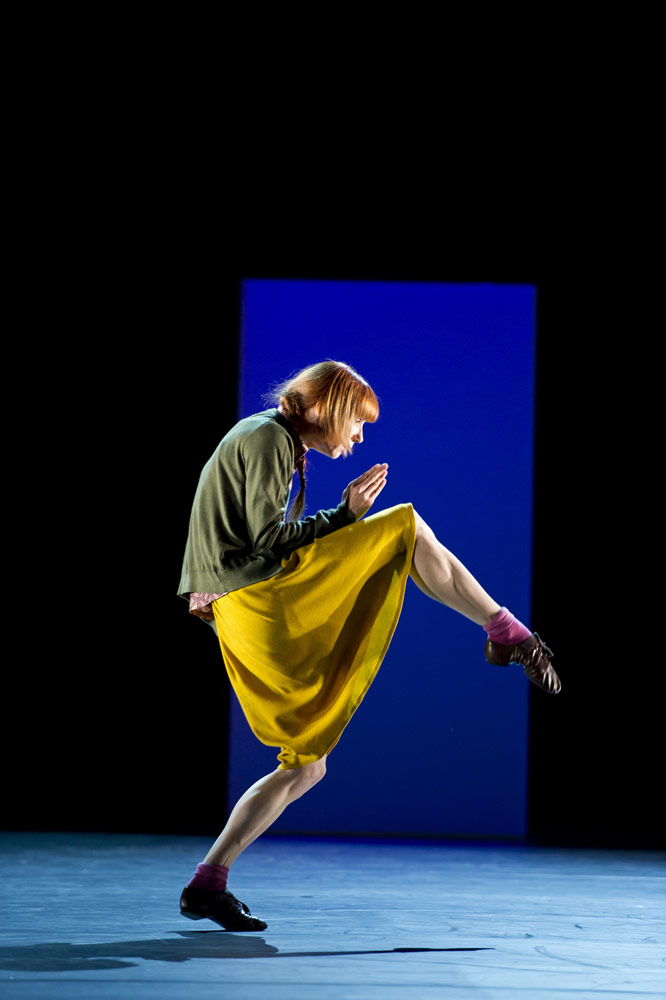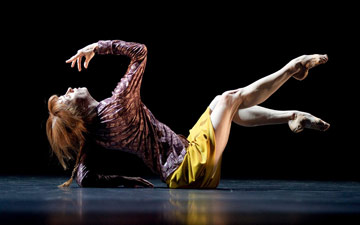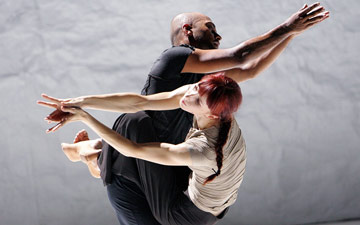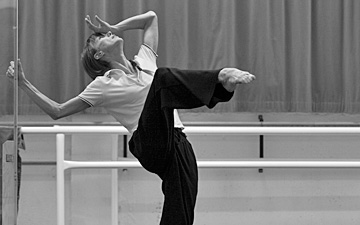
© Bill Cooper. (Click image for larger version)
Sylvie Guillem
Life in Progress: technê, DUO2015, Here & After, Bye
New York, City Center
12 November 2015
www.sylvieguillem.com
www.nycitycenter.org
More than one dancer has been dubbed a “punk ballerina” but no one deserves it more than Sylvie Guillem, who has ruffled feathers at the world’s best companies, and at 50 years old is still on top.
Watching her onstage at City Center performing Life in Progress – her farewell tour which capitalizes on Guillem’s free-spiritedness and features works by longstanding Guillem collaborators – it’s easy to forget she began her career mastering the classics.

© Gilles Tapie. (Click image for larger version)
Most balletomanes know her story: Rudolf Nureyev plucked a teenage Sylvie Guillem from the lower ranks of the Paris Opera Ballet and made her a star [etoile] when she was 18. She conquered the classical repertoire quickly, starring in Nureyev’s robust productions such as Raymonda and La Bayadere and took on contemporary works with gusto. Craving freedom, she fled POB for the Royal Ballet, and stayed until she once again felt the walls closing in. She has unquestionably changed dance: like it or lump it, her physique – which allowed her unparalleled flexibility without compromising classical requirements – created a new standard (though few measure up) and while Baryshnikov and Nureyev were allowed to collaborate outside their companies and choose partners, Guillem was the first female dancer to do so.
For the latter part of her career she has been largely nomadic, calling her own shots, performing internationally and savoring collaborative work with today’s “it” choreographers. Guillem, for all her classical background, never looks out of place in the contemporary realm, where she fully commits, and dances within the steps rather than on top of them, forcibly. If she was unconquerable as a ballerina, she most definitely is so now as a complete artist, whose astonishing versatility, musicality and instinct are nowhere more visible than in Life in Progress.

© Bill Cooper. (Click image for larger version)
Akram Khan’s program notes for his piece technê talk a lot about memory: “…is art then the memory of movement, and of being moved?” A feral, zoomorphic Guillem skitters across the stage in a crouched position – part beetle, part ape. The music here is more like a sound effect, of an insect busily scraping each of his six little legs. Guillem is a creature apart. The precision with which she moves has always been stupefying, and now more than ever. The choreography eventually climbs upwards, and the ferocity with which Guillem throws her body around, the momentum she achieves in spins that she can then stop in a millisecond, is breathtaking. Exactitude as wild abandon. It is hard, nigh impossible to imagine anyone else embodying such opposites so well.
William Forsythe created the seminal In the Middle, Somewhat Elevated on Guillem in the late 1980s, a work that permanently altered the dancescape. She doesn’t perform Forsythe in Life in Progress, but Forsythe is represented by Duo2015, starring two male dancers, Brigel Gjoka and Riley Watts.

© Bill Cooper. (Click image for larger version)
The witty, fluid duet is funny, nimble and so quick if you blink you’ll miss a joke. Gjoka’s goofiness is particularly savvy, and Watts is a flawless straightman counterpoint. The two bodies wind over and under each other at Forsythean angles, contrasting soft and hard, the composite result supposedly emulating a clock made up of two bodies. It comes across – most of the time (and definitively at the end) – but the most pleasurable aspect beyond the humor is Gjoka’s lithe, unflappable movements. Appearing at once boneless and structured, his gumminess revolves around the rigorous architecture of his frame, giving a sense of weight and groundedness often lacking in other sinewy choreographers like Naharin or McGregor.
Here & After from Russell Maliphant stars Guillem and Teatro alla Scala’s Emanuela Montanari, and opens like a slow, dimly-lit tai chi pas de deux. Guillem and Montanari move meditatively in stripey, orange light. The second half is more dynamic, revealing a pulsating drum and bass score and increased velocity. Guillem’s limbs still fly with the limber looseness, hyperextension and control that is her signature, a mere shrug for her, a casual (and very French) flawlessness. The second half is marked by an increase in swift interactions and partnering between Montanari and Guillem, but even here it plateaus, lacking in highs and lows despite the swiveling spins and lifts.

© Bill Cooper. (Click image for larger version)
Guillem saves the most visible piece for the last. Her longtime collaborations with Swedish choreographer Mats Ek have resulted in some heartbreaking works. Photographs from Ek’s Bye, created specially for Guillem, are the anchor images for her farewell campaign: a woman in “librarian” garb (bangs/fringe, an olive cardigan, knee-length mustard skirt, socks and brogues) pitching backwards, her arms and chin up, her legs in an exaggerated march, looking like an ecstatic version of Monty Python’s “Ministry of Silly Walks.”
Ek’s three sentence program commentary on Bye is all Scandinavian minimalism: “A woman enters a room. After a while she is ready to leave it. Ready to join others.”

Given Ek’s claustrophobic, psychological, theatrical intensity as witnessed in works such as Apartment and Smoke, it’s hard not to attach a narrative to Bye, perhaps that of an agoraphobic introvert for whom going to a party, socializing, is, every time, an exhausting contradiction of the self. This could be an erroneous assumption on my part, but Bye is a playful work and an exquisite vehicle for Guillem at her best.
The curtain lifts to reveal a single, massive eyeball – Guillem’s – on a tall, rectangular screen. She blinks, stares at the audience, and walks away from us, revealing her full body in black and white. She reaches up, and her real flesh and bone hands come over the screen – the audience gasps and giggles. Guillem comes out from behind the screen and embarks on a stage-wide escapade to Beethoven’s bipolar Arietta Sonata, which juxtaposes the composer’s bittersweet gravity with manic frivolity, particularly given Ek’s choice of recording – by Igo Pogorelich – which boasts a pronounced ragtime rhythm.

Guillem’s character is restless, fidgety, curious and maybe, for all her solitariness, a little bored. She rocks like a doll, then kicks up her legs with a vaudevillian pedestrianism. She wrestles with her shoes, removes them and tears across the stage in a fantastic melee of jagged and sublime movement during Beethoven’s ragtime romp. Her body forms planes, flings, flutters, grips itself in quick freeze moments. She falls into the softness of one movement and abruptly hacks it in two. She stands on her head, her legs wide open; the audience laughs at the absurdity but it seems a kind of agony – neuroses personified. The screen she left fills with people and she knows they’re there, on the other side. She finally puts on her shoes and joins them, but only after we’ve witnessed a consuming cocktail of gleeful anticipation and anxiety.

© Bill Cooper. (Click image for larger version)
The only time I met Guillem, she came out of a stage door wearing leathers and boots. She signed autographs, put a helmet on over her shock of a bright red bob, and hopped on the back of a motorcycle, riding off with her arms around a strapping young man. I was seven years old, and I have never thought of Guillem as a sweet little ballerina (nor have many others).
27 years later, she remains true to her punk self, and no one could say she has not made the most of her potential. Guillem is going out on the highest of notes.

















I enjoyed reading your wonderfully expressive review. Your use of beautiful,eloquent lines and phrases kept me well engaged while reading the piece. I’ll certainly look forward to future reviews, as you certainly have a remarkable ability to practically imagine myself, witnessing from the wings!